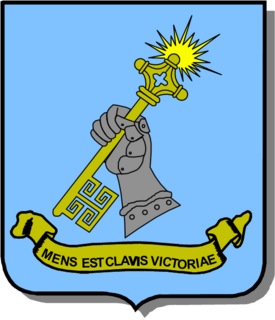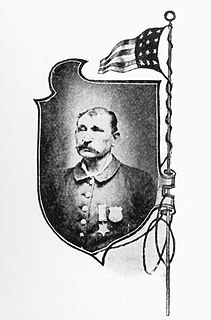
The United States Military Academy (USMA), also known as West Point, Army, Army West Point, The Academy, or simply The Point, is a four-year federal service academy in West Point, New York. It was originally established as a fort that sits on strategic high ground overlooking the Hudson River with a scenic view, 50 miles (80 km) north of New York City. It is one of the four U.S. military service academies, and one of the five U.S. service academies.

The School of Advanced Military Studies (SAMS) is one of four United States Army schools that make up the United States Army Command and General Staff College (CGSC) at Fort Leavenworth, Kansas. This "enormously rigorous" graduate school comprises two programs: the larger Advanced Military Studies Program (AMSP), and the Advanced Operational Art Studies Fellowship (AOASF), which more senior officers attend. The student body is small but diverse and comprises members of each of the US armed forces, various US government agencies, and allied military forces. Graduates are colloquially known as "Jedi Knights".

The Chief of Staff of the Army (CSA) is a statutory office held by a four-star general in the United States Army. As the most senior uniformed officer assigned to serve in the Department of the Army, the CSA is the principal military advisor and a deputy to the Secretary of the Army. In a separate capacity, the CSA is a member of the Joint Chiefs of Staff and, thereby, a military advisor to the National Security Council, the Secretary of Defense, and the President of the United States. The CSA is typically the highest-ranking officer on active-duty in the U.S. Army unless the Chairman or the Vice Chairman of the Joint Chiefs of Staff are Army officers.

The United States Army War College (USAWC) is a U.S. Army educational institution in Carlisle, Pennsylvania, on the 500-acre (2 km²) campus of the historic Carlisle Barracks. It provides graduate-level instruction to senior military officers and civilians to prepare them for senior leadership assignments and responsibilities. Each year, a number of Army colonels and lieutenant colonels are considered by a board for admission. Approximately 800 students attend at any one time, half in a two-year-long distance learning program, and the other half in an on-campus, full-time resident program lasting ten months. Upon completion, the college grants its graduates a master's degree in Strategic Studies.

The Naval History and Heritage Command, formerly the Naval Historical Center, is an Echelon II command responsible for the preservation, analysis, and dissemination of U.S. naval history and heritage located at the historic Washington Navy Yard. The NHHC is composed of 42 facilities in 13 geographic locations including the Navy Department Library, 10 museums and 1 heritage center, USS Constitution repair facility and detachment, and historic ship ex-USS Nautilus.

The Army Medical Department of the U.S. Army (AMEDD), formerly the Army Medical Service (AMS), encompasses the Army's six medical Special Branches. It was established as the "Army Hospital" in July 1775 to coordinate the medical care required by the Continental Army during the Revolutionary War. The AMEDD is led by the Surgeon General of the U.S. Army, a lieutenant general.

Fort Lesley J. McNair is a United States Army post located on the tip of Greenleaf Point, the peninsula that lies at the confluence of the Potomac River and the Anacostia River in Washington, D.C. To the peninsula's west is the Washington Channel, while the Anacostia River is on its south side. Originally named Washington Arsenal, the fort has been an army post for more than 200 years, third in length of service, after the United States Military Academy at West Point and the Carlisle Barracks. The fort is currently named for Lesley J. McNair, a U.S. Army General who was killed in action in World War II.

The Air University (AU), headquartered at Maxwell Air Force Base, Alabama, is the U.S. Air Force's center for professional military education (PME). It is a key component of the Air Education and Training Command (AETC).

The Louisiana National Guard consists of the Louisiana Army National Guard, a reserve component of the United States Army, and the Louisiana Air National Guard, a reserve component of the United States Air Force, under the United States Department of Defense.

The Air Force Historical Research Agency is the repository for United States Air Force historical documents. The Agency's collection, begun during World War II in Washington, D.C. and moved in 1949 to Maxwell Air Force Base, the site of Air University, to provide research facilities for professional military education students, the faculty, visiting scholars, and the general public.

The Walter Reed Army Institute of Research (WRAIR) is the largest biomedical research facility administered by the U.S. Department of Defense (DoD). The institute is centered at the Forest Glen Annex, part of the unincorporated Silver Spring urban area in Maryland just north of Washington, DC, but it is a subordinate unit of the U.S. Army Medical Research and Materiel Command (USAMRMC), headquartered at nearby Fort Detrick, Maryland. At Forest Glen, the WRAIR has shared a laboratory and administrative facility — the Sen Daniel K. Inouye Building, also known as Building 503 — with the Naval Medical Research Center since 1999.

The Military Intelligence Corps is the intelligence branch of the United States Army. The primary mission of military intelligence in the United States Army is to provide timely, relevant, accurate, and synchronized intelligence and electronic warfare support to tactical, operational and strategic-level commanders. The Army's intelligence components produce intelligence both for Army use and for sharing across the national intelligence community.

The United States Army Heritage and Education Center (USAHEC), at Carlisle Barracks, Pennsylvania, is the U.S. Army's primary historical research facility. Formed in 1999 and reorganized in 2013, the center consists of the Military History Institute (MHI), the Army Heritage Museum (AHM), the Historical Services Division (HSD), Visitor and Education Services (VES), the U.S. Army War College Library, and Collections Management (CM). The U.S. Army Heritage and Education Center is part of the United States Army War College, but has its own 56-acre (230,000 m2) campus.

William R. Pelham was a Union Navy sailor during the American Civil War and a recipient of the United States military's highest decoration—the Medal of Honor—for his actions at the Battle of Mobile Bay.
The Army Heritage Center Foundation (AHCF) is a membership based 501(c)(3) nonprofit corporation that is coordinating a public-private partnership to assist the United States Army to develop the U.S. Army Heritage and Education Center (USAHEC) in Carlisle, Pennsylvania.

The United Nations Educational, Scientific and Cultural Organization is a specialized agency of the United Nations (UN) based in Paris. Its declared purpose is to contribute to peace and security by promoting international collaboration through educational, scientific, and cultural reforms in order to increase universal respect for justice, the rule of law, and human rights along with fundamental freedom proclaimed in the United Nations Charter. It is the successor of the League of Nations' International Committee on Intellectual Cooperation.

The United States Marine Corps History Division is a branch of Headquarters Marine Corps tasked with researching, writing, and maintaining the History of the United States Marine Corps. It also provides reference and research assistance; preserves personal experiences and observations through oral history interviews; and deploys field historians to record history in the making. It is headquartered at Marine Corps Base Quantico in Virginia.
The 543d Aircraft Control and Warning Group is a disbanded United States Air Force unit. It was last assigned to the 31st Air Division, Air Defense Command, stationed at Fort Snelling, Minnesota. It was inactivated on 10 February 1952.

The Junior Reserve Officers' Training Corps (JROTC) is a federal program sponsored by the United States Armed Forces in high schools and also in some middle schools across the United States and United States military bases across the world. The program was originally created as part of the National Defense Act of 1916 and later expanded under the 1964 ROTC Vitalization Act.


















